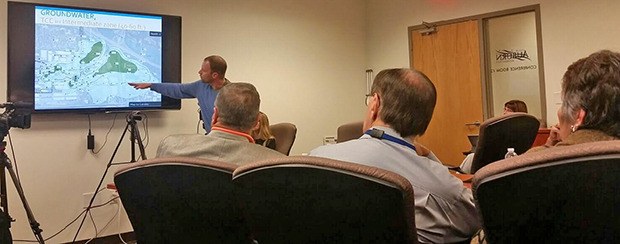It is trichloroethylene, or TCE, a chlorinated hydrocarbon, which the Boeing Company used in two areas on its Auburn property from the 1960s through the late 1980s to degrease and clean airplane parts.
TCE is a carcinogen.
Years after Boeing had discontinued its use of TCE, the company discovered that, from those two sources, the chemical had seeped into the groundwater and spread out northwest to create a flume more than a mile long, extending past Highway 18 into parts of southwest Auburn and northeast Algona.
Neal Hines, who has overseen the subsequent spill investigation for the state Department of Ecology, on Monday brought the Auburn City Council up to date.
Whereas 5 parts per billion TCE is drinking water standard, Hines said, the highest concentration measured so far in the contamination area at depths between 40 and 60 feet has been 9 parts per billion.
In areas of lesser concentration, that is, between 1 and 30 feet, the highest measure was 2.4 parts per billion.
“It’s over a mile long and stretches contamination over a large area, but in terms of concentrations, you’re looking at some areas that are right at the cleanup standard, most cases that are below, and in a few cases above,” Hines said.
State standards for cleanup of TCE are about 2.4 parts per billion.
“What we have found is that the surface water record since collected has not been a health concern,” Hines said.
Ecology has conducted vapor tests of indoor air and the air space above surface water to determine whether chemicals are passing from the groundwater to the air as vapor, and these test have shown that the concentrations are safe.
Hines cited tests that have shown that wells from which people draw drinking water, typically about 250 feet, do not overlap with the levels at which contamination has been found.
Hines said a remedial investigation is necessary to understand the source and extent of the contamination at the site.
An extensive network of wells has been installed throughout the site to monitor the locations and concentrations of contaminants over time. The Department of Health monitors the drinking supplies regularly, which are a safe distance away from the contamination.


